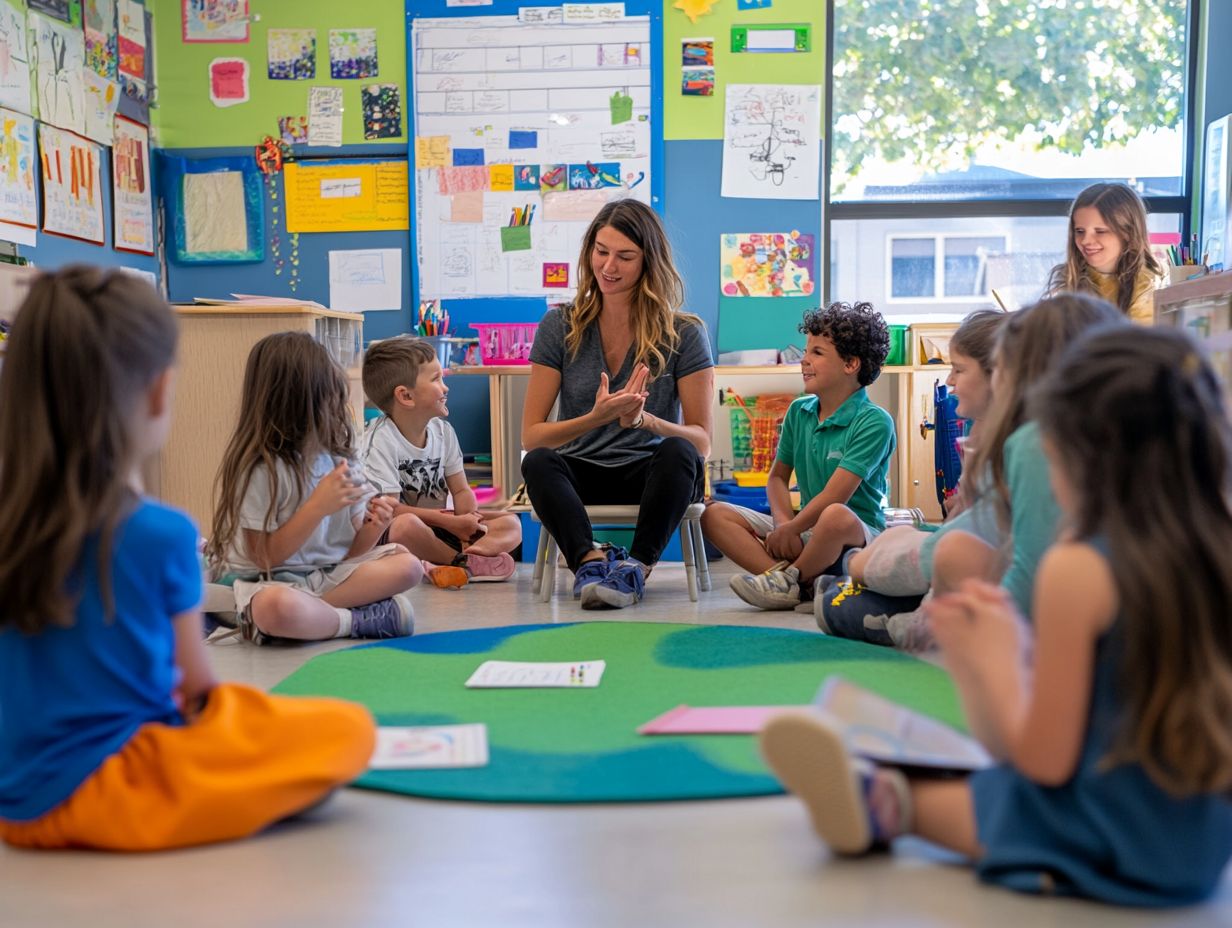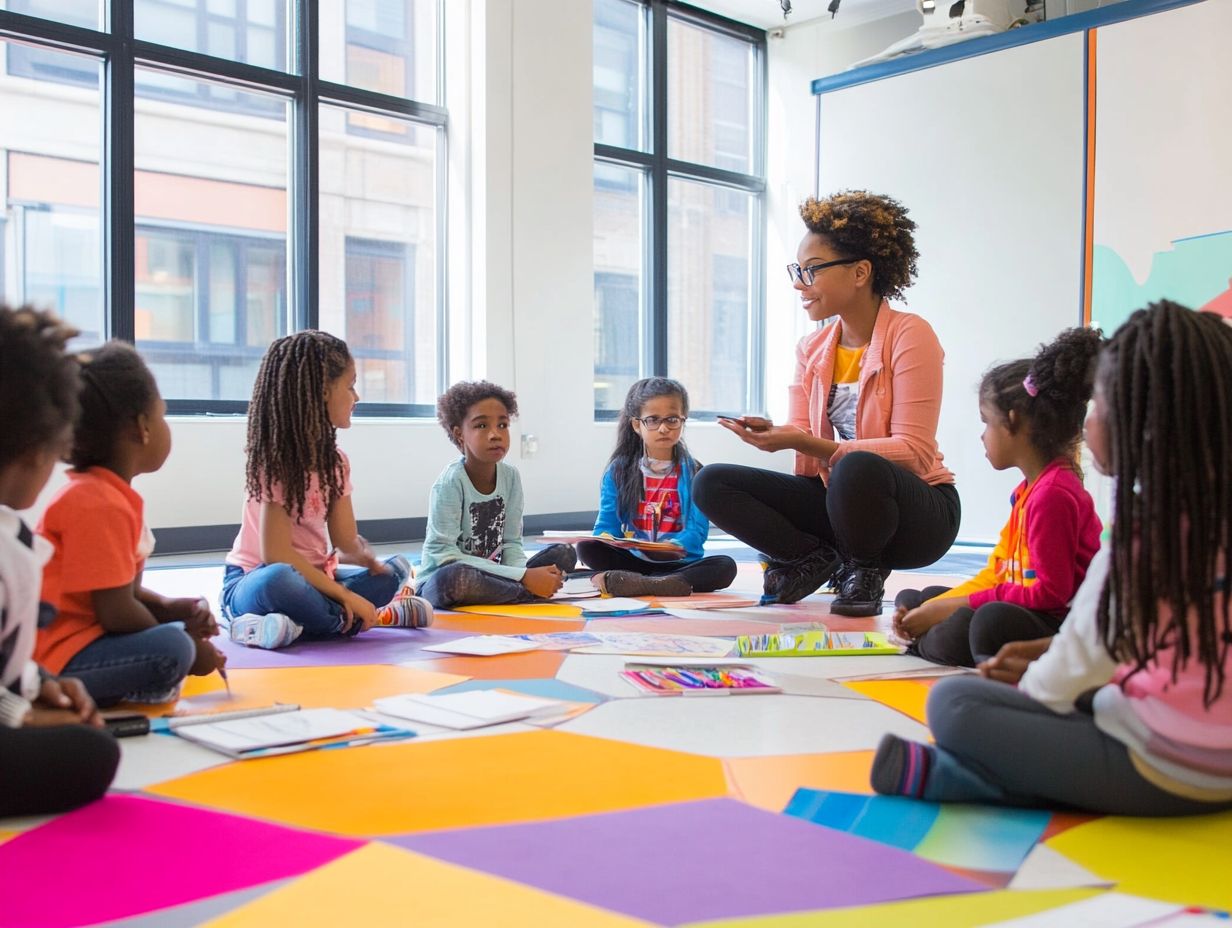active learning: engagement strategies for students
Active learning revolutionizes traditional education by engaging you in the learning process, fostering a deeper understanding and retention of knowledge.
This article delves into the essence of active learning, its significance, and the myriad benefits it offers, particularly in enhancing critical thinking and boosting engagement among students.
Get ready to energize your classroom and empower your students like never before!
Dive into effective strategies that will transform your classroom!
Contents
- Key Takeaways:
- Understanding Active Learning
- The Benefits of Active Learning for Students
- Engagement Strategies for Active Learning
- Creating a Supportive Environment for Active Learning
- Common Questions About Active Learning
- What is active learning and why is it important for students?
- What are some effective engagement strategies for students in active learning?
- How can technology be used to promote active learning and engagement in students?
- What are the benefits of incorporating active learning into the classroom?
- How can teachers create a supportive and inclusive environment for active learning?
- Can active learning be used in all subject areas and grade levels?
Key Takeaways:

- Active learning promotes critical thinking and boosts retention, leading to a deeper understanding of the subject matter.
- Incorporating technology, collaborative learning, and real-world applications can enhance student engagement and motivation.
- A supportive environment, with clear roles for both teachers and students, is essential for successful implementation of active learning strategies.
Understanding Active Learning
Active learning signifies a transformative shift in education, enabling you to take ownership of your learning through engagement strategies that promote collaboration and critical thinking.
By prioritizing real-world applications and interactive classroom techniques, you can cultivate a vibrant environment where you truly thrive. This approach supercharges retention and transforms your learning experience!
In essence, active learning is a dedication to nurturing your natural curiosity and fostering meaningful connections within the classroom.
What is Active Learning and Why is it Important?
Active learning is an educational method designed to fully engage you in the learning process. It encourages participation, critical thinking, and the application of concepts to real-world scenarios.
By cultivating a dynamic learning environment, this method shifts your focus from passively receiving information to actively participating, significantly enhancing your understanding and retention of material.
Various components contribute to this method, including collaborative activities, hands-on experiences, and timely feedback.
The benefits are substantial: you often find yourself more motivated and achieving improved academic performance.
Instructional strategies, such as think-pair-share where you think about a question, discuss your thoughts with a partner, and then share with the larger group encourage you to think independently, stimulating dialogue and deepening your comprehension.
Similarly, gamification introduces elements of play into educational tasks, making your learning experience more engaging and enjoyable. This ultimately leads to a richer and more interactive classroom atmosphere.
The Benefits of Active Learning for Students
Active learning presents you with a wealth of advantages, from significantly improving your retention of information to sharpening your critical thinking abilities.
You’ll also notice a remarkable boost in your motivation and engagement during lessons, making your educational experience not just productive but truly enjoyable.
Improved Retention and Critical Thinking Skills
One of the most remarkable benefits of active learning lies in its capacity to enhance information retention and cultivate critical thinking skills. By engaging in activities like collaborative group discussions or interactive lectures, you don t just absorb the material; you also learn to articulate your thoughts with clarity.
Take, for instance, discussion warm-ups. These allow you to connect new concepts with what you already know, making the information not only more relatable but also easier to remember. Reading aloud fosters auditory processing and aids retention, transforming passive learning into an engaging dialogue.
These techniques promote deeper cognitive engagement, encouraging you to analyze, evaluate, and create rather than simply memorize. When you immerse yourself in problems through active exploration, you develop a richer understanding that leads to lasting skills extending far beyond the classroom.
Increase in Student Engagement and Motivation

Active learning strategies can significantly elevate your engagement and motivation by enabling you to take ownership of your learning experience. This approach transforms the traditional classroom dynamics.
Working together on projects helps you understand topics better and build teamwork skills. For example, one class remarkably improved their learning outcomes through a group project that tasked them with creating a multimedia presentation on environmental issues.
Students shared how this hands-on approach made the topics more relatable and enjoyable. As a result, they invested more in their studies.
Gamification techniques are effective; a recent survey revealed that students felt more enthusiastic about attending classes when competitive elements and rewards were woven into their activities.
Engagement Strategies for Active Learning
Implementing effective engagement strategies is crucial for cultivating an environment of active learning in your classroom. This approach enables students to connect with the material through innovative technology and collaborative learning techniques.
Incorporating educational technology in your classroom can significantly enhance active learning. This transforms lessons into interactive and engaging experiences for your students.
Utilizing tools like podcasts allows your learners to delve into subjects at their own pace. This enriches their understanding through engaging auditory experiences.
Meanwhile, digital quizzes offer immediate feedback, reinforcing knowledge and boosting student confidence. Interactive learning stations create hands-on opportunities, encouraging collaboration among peers.
Together, these platforms reinvent the traditional educational experience. They foster an environment where technology actively supports engagement and strategic instruction.
As a result, your students become more invested in their education, often taking greater ownership of their own learning journeys.
Collaborative Learning Techniques
Collaborative learning techniques, such as group work and think-pair-share, create an environment where you can learn from your peers and take ownership of your educational journey. These methods foster interaction among students and deepen your understanding of concepts.
For instance, imagine a project centered around a community service initiative. This allows you and your classmates to come together to plan and execute a charitable event, honing critical thinking and problem-solving skills.
Consider the jigsaw method, where each student becomes an expert on a specific aspect of a topic. This approach sparks rich class discussions, engaging everyone in the learning process.
The results of such collaborative projects often include heightened enthusiasm for learning and enhanced communication skills. You also develop a stronger sense of responsibility, equipping you for real-world collaboration.
Real-World Application and Project-Based Learning
Real-world application and project-based learning offer you the chance to engage deeply with content, making lessons relevant and captivating. By bridging the gap between theory and practice, you create a learning environment where concepts are lived and experienced.
Imagine designing a sustainable garden! Not only do you get to apply biology principles in exciting new ways, but you also foster teamwork and creativity.
Such experiences enhance the retention of academic knowledge and instill a sense of purpose and connection to the community. When you see the tangible outcomes of your efforts, your motivation skyrockets.
It s a testament to the profound impact that real-world projects can have on your learning journey.
Creating a Supportive Environment for Active Learning

Creating a supportive environment for active learning requires you to redefine the roles of both teachers and students.
It s essential to address the potential challenges and barriers that can arise in the classroom, ensuring that everyone is enabled to engage fully in the learning process.
Teacher and Student Roles in Active Learning
In an active learning environment, you’ll notice a remarkable shift in the roles of both teachers and students, placing a strong emphasis on collaboration, guidance, and shared responsibility for learning.
Here, the teacher transitions into a guide, sparking inquiry and discussion rather than simply delivering content.
For example, you might find educators using projects where students work together to tackle real-world challenges, honing their teamwork and critical thinking skills.
By incorporating technology think interactive simulations or online forums you can explore subjects at your own pace, fostering a genuine sense of ownership over your education.
By nurturing a culture of openness and valuing diverse perspectives, educators enable you to take the reins of your learning journey, ultimately equipping you for a dynamic and complex world.
Addressing Challenges and Overcoming Barriers
Addressing challenges and overcoming barriers is essential for you to successfully implement active learning strategies and maintain sustained student engagement.
As an educator, you may encounter obstacles like resistance to change, inadequate training, and limited resources.
To effectively tackle these issues, your institution could invest in continuous professional development and provide access to collaborative learning communities.
Embracing technology can also ease the transition, offering a wealth of diverse resources and tools that enhance the learning experience.
By gradually introducing active learning techniques, you can refine your instructional strategies, allowing your students to adjust comfortably while increasing their participation.
We must address these challenges now to ensure effective learning.
Common Questions About Active Learning
What is active learning and why is it important for students?
Active learning is an educational approach that involves students taking an active role in their learning process. This includes engaging in hands-on activities, participating in discussions, and applying their knowledge to real-world situations. It s crucial for students as it boosts motivation, enhances critical thinking, and helps them remember what they learn.
What are some effective engagement strategies for students in active learning?

Some effective engagement strategies for students in active learning include group work, problem-based learning, flipped classrooms, and peer teaching. These strategies encourage students to actively participate and collaborate with their peers, which can lead to a deeper understanding of the material.
How can technology be used to promote active learning and engagement in students?
Technology can be used in various ways to promote active learning and engagement in students. This can include using online platforms for group discussions and collaboration, incorporating multimedia elements into lessons, and using interactive games and simulations to reinforce concepts and skills.
What are the benefits of incorporating active learning into the classroom?
Incorporating active learning into the classroom has numerous benefits, including increased student engagement, improved critical thinking and problem-solving skills, and a more personalized and interactive learning experience. It also prepares students for real-world situations where they will need to actively apply their knowledge and skills.
How can teachers create a supportive and inclusive environment for active learning?
To create a supportive and inclusive environment for active learning, teachers can encourage open communication. They should provide opportunities for all students to share their ideas.
Building a classroom where everyone feels safe and respected is crucial. Teachers must also be aware of different learning styles and offer a variety of activities to meet everyone s needs.
Can active learning be used in all subject areas and grade levels?
Absolutely! Active learning works in every subject and grade. It s a flexible approach that adapts to different topics and goals.
For example, in a science class, students can conduct experiments. In literature, they can join discussions or try creative writing. The exciting part? Active learning shines in both elementary and secondary classrooms!





